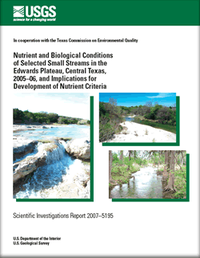Nutrient and biological conditions of selected small streams in the Edwards Plateau, central Texas, 2005-06, and implications for development of nutrient criteria
Links
- More information: USGS Index Page (html)
- Document: Report (48.6 MB pdf)
- Download citation as: RIS | Dublin Core
Abstract
During the summers of 2005 and 2006 the U.S. Geological Survey, in cooperation with the Texas Commission on Environmental Quality, evaluated nutrient and biological conditions in small streams in parts of the Edwards Plateau of Central Texas. Land-cover analysis was used to select 15 small streams that represented a gradient of conditions with the potential to affect nutrient concentrations across the study area, which comprises two of four subregions of the Edwards Plateau ecoregion. All 15 streams were sampled for water properties, nutrients, algae, benthic invertebrates, and fish in summer 2005, and eight streams were resampled in summer 2006. Streams that did not receive wastewater effluent had relatively low nutrient concentrations and were classified as oligotrophic; streams receiving wastewater effluent had relatively high nutrient concentrations and were classified as eutrophic. Nutrient concentrations measured in the least-disturbed streams closely matched the U.S. Environmental Protection Agency nutrient criteria recommendations based on estimated reference concentrations. Nitrogen/phosphorus ratios indicated streams not affected by wastewater effluent might be limited by phosphorus concentrations. Algal indicators of nutrient condition were closely related to dissolved nitrogen concentrations and streamflow conditions. Ambient dissolved nitrogen concentrations (nitrite plus nitrate) were positively correlated with benthic algal chlorophyll-a concentrations. The correlation of benthic algal chlorophyll-a with instantaneous nitrite plus nitrate load was stronger than correlations with ambient nutrients. Increased nutrient concentrations were associated with increased macroalgae cover, wider diel dissolved oxygen ranges, and reduced diel dissolved oxygen minimums. Benthic invertebrate aquatic life use scores generally were classified as High to Exceptional in study streams despite the influence of urbanization or wastewater effluent. Reductions in aquatic life use scores appeared to be related to extremely low flow conditions and the loss of riffle habitats. Benthic invertebrate aquatic life use scores and several of the metrics used to compute composite aquatic life use scores tended to increase with increasing total nitrogen concentrations. Fish community aquatic life use scores generally were classified as High or Exceptional with the exception of a few samples collected from streams receiving wastewater effluent that were classified as Intermediate. Fish community aquatic life use scores and several fish community metrics were positively correlated with nutrient concentrations and macroalgae cover. The majority of the positive correlations among nutrient concentrations, macroalgae cover, and fish metrics were strongly influenced by relatively high nutrient concentrations. Both benthic and planktonic chlorophyll-a measures were related to nutrients, but this study indicates that benthic chlorophyll-a was the better choice for monitoring nutrient enrichment because (1) the relation between benthic chlorophyll-a and nutrients was stronger, and (2) a strong relation between benthic chlorophyll-a and nutrients persisted after removal of the sites influenced by wastewater effluent, which indicates superior ability of benthic chlorophyll-a to discriminate between conditions at lower nutrient concentrations. The transect-based algal abundance estimate technique is a useful tool for identifying eutrophic conditions, assessing nuisance algal growth, and making broad comparisons among sites, but it appears to lack the fine resolution to identify lesser degrees of nutrient enrichment. Several individual benthic invertebrate and fish metrics were correlated with nutrient conditions, but correlations were generally positive and the reverse of what would be expected when nutrient enrichment causes a proliferation of algal growth and stream degradation. However, the benthic invertebrate functional feeding group metrics showed some
Study Area
| Publication type | Report |
|---|---|
| Publication Subtype | USGS Numbered Series |
| Title | Nutrient and biological conditions of selected small streams in the Edwards Plateau, central Texas, 2005-06, and implications for development of nutrient criteria |
| Series title | Scientific Investigations Report |
| Series number | 2007-5195 |
| DOI | 10.3133/sir20075195 |
| Edition | Version 1.0 |
| Year Published | 2007 |
| Language | English |
| Publisher | U.S. Geological Survey |
| Publisher location | Reston, VA |
| Contributing office(s) | Texas Water Science Center |
| Description | vi, 47 p. |
| Time Range Start | 2005-01-01 |
| Time Range End | 2006-12-31 |
| Online Only (Y/N) | N |
| Additional Online Files (Y/N) | N |


